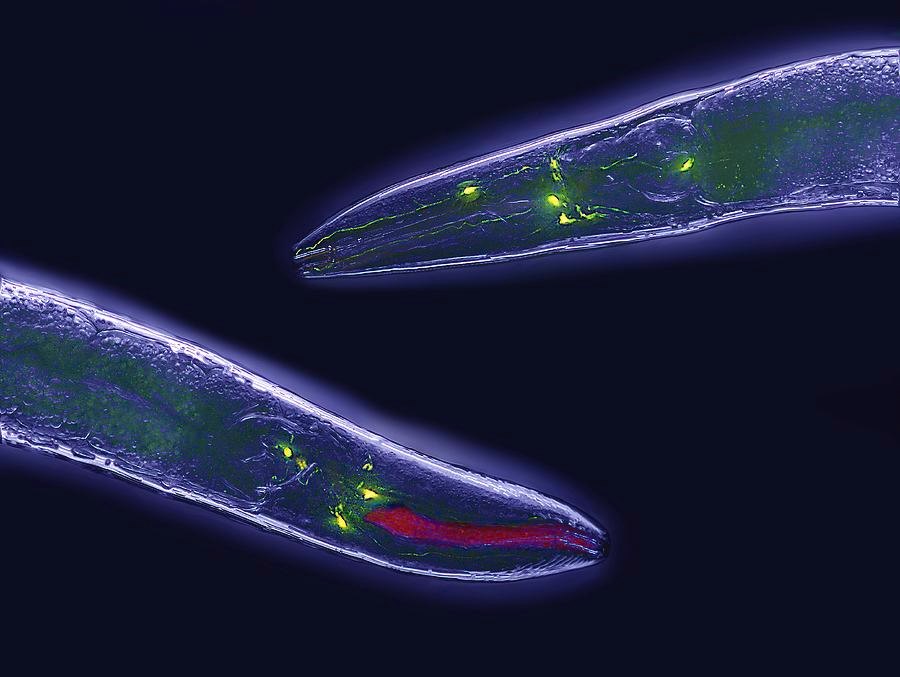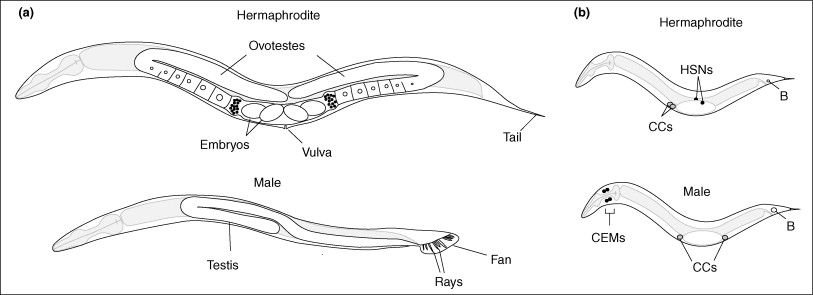Introduction
Caenorhabditis elegans (C. elegans) is a tiny, transparent, free-living nematode (roundworm) that has become one of the most important model organisms in developmental biology, genetics, and neuroscience. Its simple anatomy, short life cycle, and fully sequenced genome make it ideal for studying the development of multicellular organisms. One of the most unique aspects of C. elegans is its deterministic development, where each cell division and fate is known and reproducible from one individual to another.

Summary of Caenorhabditis elegans
- Model Organism Excellence:
Caenorhabditis elegans is a small, transparent nematode used extensively in scientific research due to its simple anatomy, short life cycle, fully mapped genome, and predictable cell development. It has helped uncover fundamental biological processes like apoptosis, RNA interference, and neural connectivity. - Deterministic Development:
Every adult Caenorhabditis elegans hermaphrodite has exactly 959 somatic cells with a completely mapped and invariant cell lineage. This makes it a powerful model for studying embryogenesis, organ formation, and cell differentiation with unmatched precision. - Impact on Human Biology:
Despite its simplicity, Caenorhabditis elegans shares many genetic and cellular mechanisms with humans. It has significantly contributed to our understanding of genetics, development, and disease, including cancer and neurodegeneration, making it essential in biomedical research.
Table of Contents
Overview of Caenorhabditis elegans
General Features
- C. elegans is about 1 mm in length.
- It is transparent throughout its life.
- It can be easily cultured on agar plates seeded with bacteria.
- It has two sexes: hermaphrodites and males.
- The hermaphrodite has 959 somatic cells as an adult.
- Its genome contains approximately 20,000 genes.
Advantages as a Model Organism
- Short generation time (around 3 days).
- Simple body plan.
- Transparent body allows for real-time observation.
- Well-characterized genetics and developmental lineage.
- Amenable to genetic manipulation including RNAi and CRISPR.
Life Cycle of Caenorhabditis elegans

Embryonic Development
Embryogenesis begins with fertilization inside the hermaphrodite. The zygote undergoes a series of rapid and well-coordinated cell divisions leading to the formation of a multicellular embryo.
Stages of Embryonic Development
Zygote Formation and Cleavage
- Fertilization occurs in the spermatheca of the hermaphrodite.
- The first cleavage is asymmetric, producing a larger anterior AB cell and a smaller posterior P1 cell.
- Subsequent cleavages generate distinct cell lineages.
Gastrulation
- Begins around the 26-cell stage.
- Involves the inward migration of endodermal and mesodermal precursors.
- Establishes the three germ layers: ectoderm, mesoderm, and endoderm.
Organogenesis
- Occurs after gastrulation.
- Includes formation of pharynx, gut, muscle cells, hypodermis, and nervous system.
Elongation and Hatching
- The embryo elongates and rotates inside the eggshell.
- Hatching occurs about 14 hours after fertilization at 20°C.
Post-Embryonic Development
Larval Stages
C. elegans goes through four larval stages (L1 to L4) before reaching adulthood. Each stage is separated by a molt.
L1 Stage
- The larva hatches from the egg.
- Basic body plan is already established.
- Begins feeding on bacteria.
L2 Stage
- Continuation of growth and development.
- In adverse conditions, the L2 larva can enter an alternative stage called dauer.
L3 Stage
- Further growth.
- Initiation of gonad development.
L4 Stage
- Final larval stage before adulthood.
- Completion of vulva and gonad development.
Adult Stage
- Reproductive organs are fully developed.
- Hermaphrodite begins producing offspring.
Cell Lineage in Caenorhabditis elegans
One of the most remarkable features of C. elegans is its invariant cell lineage. Every cell division and fate is precisely known and mapped.
Major Founder Cells
- AB: Produces neurons, epidermis, and anterior pharynx.
- P1: Gives rise to EMS and P2.
- EMS: Divides into MS (mesoderm) and E (endoderm).
- P2: Gives rise to germline and other somatic cells.
- C, D, P3, and P4: Contribute to muscles, hypodermis, and germline.
Germline Development
Primordial Germ Cells
- Derived from P lineage.
- P4 gives rise to Z2 and Z3, the primordial germ cells.
Gametogenesis
- Hermaphrodites first produce sperm and then switch to oogenesis.
- Males produce only sperm.
Sex Determination in Caenorhabditis elegans

C. elegans exhibits an XX/XO system:
- XX = Hermaphrodite
- XO = Male
Sex Determination Pathway
- X:A ratio (number of X chromosomes to autosomes) determines sex.
- tra-1 gene plays a key role in promoting female development.
- fem genes (fem-1, fem-2, fem-3) promote male development when active.
Neuronal Development
C. elegans has a simple nervous system composed of 302 neurons in hermaphrodites. The full connectome (neural wiring diagram) has been mapped.
Neuroblast Lineages
- Specific neuroblasts give rise to specific neurons.
- Neurons are generated mostly during embryogenesis but continue in larval stages.
Synaptic Connectivity
- The first animal to have a complete synaptic map.
- Neurons form reproducible and precise connections.
Muscle Development
C. elegans has both body wall and pharyngeal muscles.
Myogenesis
- Muscle cells originate from founder cells like C and D.
- Transcription factors like HLH-1 (a MyoD homolog) regulate muscle fate.
Cuticle and Molting
Cuticle Structure
- A flexible, collagen-based outer layer.
- Provides shape and protection.
Molting Process
- Occurs four times (after each larval stage).
- Involves synthesis of a new cuticle and shedding of the old one.
Apoptosis and Programmed Cell Death
C. elegans undergoes precisely regulated apoptosis.
Key Genes
- ced-3, ced-4: Promote apoptosis.
- ced-9: Inhibits apoptosis.
- egl-1: Initiates apoptosis under certain conditions.
Role in Development
- Removes unnecessary or damaged cells.
- Important in shaping tissues and organs.
Dauer Formation
Under adverse conditions (crowding, starvation, high temperature), L1 larvae can enter a dauer stage—a form of developmental arrest.
Features of Dauer Stage
- Non-feeding and highly resistant to stress.
- Can survive for months.
- Development resumes upon return to favorable conditions.
Environmental Regulation of Development
C. elegans senses environmental cues through chemosensory neurons that influence development.
Key Environmental Factors
- Temperature
- Food availability
- Pheromones
Molecular Mechanisms of Development
Signaling Pathways
- Wnt Pathway: Involved in cell polarity and fate decisions.
- Notch Pathway: Controls lateral inhibition and cell differentiation.
- Ras/MAPK Pathway: Important in vulval development.
Transcription Factors
- lin-14, lin-4, let-7: Control timing of developmental events.
- unc-86: Required for neuronal specification.
RNA Interference (RNAi)
C. elegans was the first animal in which RNAi was used to silence gene expression, revolutionizing genetic studies.
Conclusion
The development of Caenorhabditis elegans is a beautifully orchestrated process characterized by precise genetic control, deterministic cell lineages, and sophisticated molecular signaling. From a single fertilized egg, this simple organism develops into a fully functioning adult in just a few days. Its remarkable transparency and genetic tractability have made it a vital tool for discovering the fundamental principles of biology and development. Whether studying cell differentiation, neural wiring, or the mysteries of aging, C. elegans continues to illuminate the path forward in biological research.
Furthermore, the ability to trace every cell from the zygote to the adult stage has provided researchers with an unparalleled framework to understand how complex organisms are formed from a single cell. Its use in apoptosis studies has also shed light on cell death mechanisms that are relevant in cancer and neurodegenerative diseases. In neuroscience, the complete connectome offers invaluable insights into how nervous systems are wired and function.
In addition, the simplicity of the organism allows for high-throughput screening in genetic and pharmacological studies. As a result, C. elegans is not only used in basic biology but is increasingly contributing to translational research, including drug discovery and toxicology.
With advancing technologies such as single-cell RNA sequencing, optogenetics, and CRISPR gene editing, the potential of C. elegans in future biological and biomedical research is vast. This tiny worm, with its humble appearance, continues to play a giant role in unraveling the secrets of life. is a beautifully orchestrated process characterized by precise genetic control, deterministic cell lineages, and sophisticated molecular signaling.
From a single fertilized egg, this simple organism develops into a fully functioning adult in just a few days. Its remarkable transparency and genetic tractability have made it a vital tool for discovering the fundamental principles of biology and development. Whether studying cell differentiation, neural wiring, or the mysteries of aging, C. elegans continues to illuminate the path forward in biological research.
FREQUENTLY ASKED QUESTIONS
What is Caenorhabditis elegans and why is it used as a model organism?
C. elegans is a small, transparent nematode (roundworm) widely used in scientific research. It’s an ideal model organism because of its simple body structure, short life cycle, fully mapped genome, and predictable cell division patterns. It helps scientists study how animals develop from a single cell into a complex, multicellular organism.
How long does it take for C. elegans to develop from an egg to an adult?
At a standard temperature of 20°C, it takes about 3 days for C. elegans to grow from a fertilized egg to a full adult. This rapid development makes it very convenient for laboratory studies.
How many cells are present in an adult C. elegans hermaphrodite?
An adult hermaphrodite has exactly 959 somatic cells, not counting the germline (egg and sperm cells). This number is consistent across all individuals, which is why its development is considered deterministic.
Related Articles




